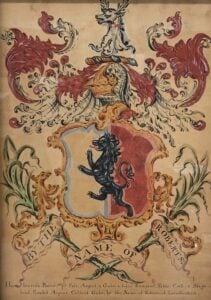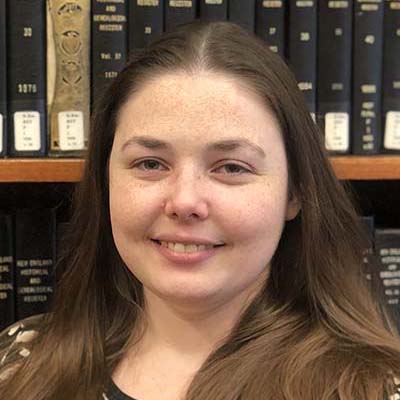 On 3 February 2020, the Committee on Heraldry at the New England Historic Genealogical Society will celebrate its 156th birthday. Known as the oldest non-governmental heraldic body in the Western world, the Committee on Heraldry task themselves with maintaining and adding to a unique collection of coats of arms associated with American families, as well as organizing educational programming to introduce more people to this artistic side of family history.
On 3 February 2020, the Committee on Heraldry at the New England Historic Genealogical Society will celebrate its 156th birthday. Known as the oldest non-governmental heraldic body in the Western world, the Committee on Heraldry task themselves with maintaining and adding to a unique collection of coats of arms associated with American families, as well as organizing educational programming to introduce more people to this artistic side of family history.
The Committee is chaired by Ryan Woods, Executive Vice President and COO at NEHGS. Woods follows in the footsteps of his kinsman, Henry Ernest Woods, who was chairman of the Committee on Heraldry from 1890 to 1911. Today, the committee of twelve meets three to four times yearly, and is charged with reviewing applications and registrations of coats of arms for Americans. These include both historical and modern coats of arms.
Qualifying historical coats of arms were granted in the home country by a national governing body, and brought to the U.S. by a descendant prior to 1900. The Roll of Arms published by NEHGS in 2013 contains the first 700 or so qualified applicants’ blazons, as well as a description of the family to whom it belongs, the immigrant ancestor, and the act or genealogical link that entitled them to carry the heraldic design. Woods estimates that about 200 applications have been approved since the 2013 publication. Additions to the collection of approved arms have been published in The Register since 1928.
Contemporary and honorary coats of arms are also reviewed and approved, though not included in this Roll of Arms collection. These would include contemporary institutions who have recently been granted arms by a governing body such as the College of Arms, in England, or the Lyon’s Court of Scotland, as well as individuals who have been granted honorary coats of arms. The act of registering these contemporary arms with the Committee on Heraldry preserves them in the American historical record, and adds to the ever-evolving tapestry of American heraldic arts.
The NEHGS special collection of Heraldic materials includes two priceless historical treasures. The Promptuarium Armorum, a comprehensive compilation of more than 4,500 historical family coats of arms, compiled by the Rouge Dragon William Crowne, was likely a practice book for one of the junior heralds at the College of Arms.
The hand-painted original copy dates from between 1602 and 1616, and was, at one time, owned by John Gore.
The hand-painted original copy dates from between 1602 and 1616, and was, at one time, owned by John Gore. Gore is thought of as the first heraldic painter in America, and presumably improved his craft utilizing the Promptuarium Armorum as a reference during the time it was in his personal possession. These two documents represent the most formative and foundational records of American heraldry. Woods, who gave a talk on these priceless artifacts, notes that “You can really see the artistic pedigree of this art form.”
The other responsibility of the Committee is one of educational programming. Woods indicated that this is a growing priority for the group. He sees a gateway in the heraldic arts: it “is an interesting way to visualize history, but also a way to introduce people to genealogy and family history. One of the things the Committee has been trying to do recently is to increase heraldic education. We had a day-long seminar here in October 2016, where we talked about heraldry generally, [with] some education on practices and vocabulary, things of that nature. Our Registrar on the Committee, Nathaniel Taylor—also the editor of The American Genealogist [or TAG]—also gave a webinar.”
More educational opportunities are coming to NEHGS soon. Woods adds that “The committee is looking to have an event here on 21 April 2020, in conjunction with the College of Arms Foundation. A member of the committee, John Shannon, is the president of the College of Arms Foundation, which is an American-based philanthropic group to help support the work of the College of Arms. We’ll look to have an event here at Newbury Street with one of the Kings of Arms from the College.”
Share this:

About Jennica Bayne
Jennica Bayne joined the Research Services team in 2019. In addition to Colonial New England and Eastern Canadian settlers, her personal research interests include early Quaker settlers of Virginia and North Carolina, their connections to the Underground Railroad, and their interactions with the Cherokee Nation, specifically the Eastern Band Cherokee. Jennica has a passion for data analysis and inheritance patterns, and she is proficient with a wide variety of genetic assessment tools and visual mapping techniques.View all posts by Jennica Bayne →